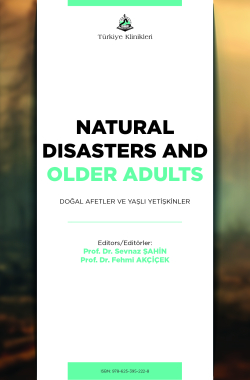The Role of Older Adults in Social Recovery After Natural Disasters
Fatma EROLa , Tuğçe KELEŞb , Fehmi AKÇİÇEKc
aEge University Faculty of Medicine, Department of Geriatrics, İzmir, Türkiye
bEge University Health Sciences Institute, Internal Medicine, Health of the Elderly Programme, İzmir, Türkiye
cEge University Faculty of Medicine, Department of Geriatrics, Retired Faculty Member, İzmir, Türkiye
Erol F, Keleş T, Akçiçek F. The role of older adults in social recovery after natural disasters. In: Şahin S, Akçiçek F, eds. Natural Disasters and Older Adults. 1st ed. Ankara: Türkiye Klinikleri; 2024. p.71-5.
ABSTRACT
Natural disasters, are extraordinary events that have a great impact on societies. Disasters have significant physical, psychological, social, and economic effects on individuals and communities. Some demographic groups are more vulnerable than others to the impacts of disasters; for instance, older people are at a greater risk in such situations. The impact of natural disasters extends beyond the physical damage; natural disasters also affect the social structure of communities. Social recovery is a component of disaster management that focuses on the restoration of social networks, community structure, and individual well-being. In this article, we aimed to address the situation and role of older people in post-disaster social recovery.
Keywords: Elderly; natural disasters; social capital; vulnerable populations
Kaynak Göster
Referanslar
- Ageing and health [internet] World Health Organizations [cited: Aug 24, 2023]. © 2023 Available from: [Link]
- Klein TA, Irizarry L. EMS Disaster Response. [Updated 2023 Jul 17]. In: StatPearls [Internet]. Treasure Island (FL): StatPearls Publishing; 2023 Jan-. Available from: [Link]
- Kristensen P, Weisæth L, Heir T. Bereavement and mental health after sudden and violent losses: a review. Psychiatry. 2012;75(1):76-97. [Crossref] [PubMed]
- Allen RS, Haley PP, Harris GM, Fowler SN, Pruthi R. Resilience: Definitions, Ambiguities, and Applications. In: Resnick B, Gwyther L, Roberto K, eds. Resilience in Aging. New York, NY: Springer; 2011. p.1-13. [Crossref]
- Fraser T, Aldrich DP, Small A. Seawalls or social recovery? The role of policy networks and design in disaster recovery, Global Environmental Change. 2021;70:102342. [Crossref]
- Fussell E. Leaving New Orleans: Social Stratification, Networks, and Hurricane Evacuation. Published June 11, 2006. [Accessed October 31, 2016]. [Link]
- Zhang J, Lu N. What matters most for community social capital among older adults living in urban China: The role of health and family social capital. International Journal Of Environmental Research And Public Health. 2019;16(4):558. [Crossref] [PubMed] [PMC]
- Putnam RD. Bowling alone: The collapse and revival of American community. 1st ed. New York: Simon and Schuster; 2000. p.19. [Crossref]
- Nyqvist F, Forsman AK, Giuntoli G, Cattan M. Social capital as a resource for mental well-being in older people: A systematic review. Aging & Mental Health. 2013;17(4):394-410. [Crossref] [PubMed]
- Kawachi I, Subramanian SV, Kim D. Social capital and health: a decade of progress and beyond; New York: Springer 2008. p. 1-26. [Crossref]
- Lin N. Building a network theory of social capital. In: Lin N, Cook K, Burt RS, eds. Social capital theory and research. 1st ed. New York: Routledge; 2001. pp. 3-25. [Crossref]
- Hodgkin S. 'I'm older and more interested in my community': Older people's contributions to social capital. Australasian Journal on Ageing. 2012;31(1):34-9. [Crossref] [PubMed]
- Brasher K. An Age-Friendly Approach to Disaster Recovery. 2020. p.6-8.
- Davey J, Neale J. Earthquake Preparedness in an Ageing Society: Learning from the experience of the Canterbury Earthquakes. Wellington, New Zealand: Victoria Univercity; 2013 p.21-30.
- Howard A, Blakemore T, Bevic M, older people as assets in disaster preparedness, response and recovery. Lessons from regional Australia, Ageing and Society, 2017;37(3):517-36. [Crossref]
- Brockie L, Miller E. Understanding Older Adults' Resilience During the Brisbane Floods: Social Capital, Life Experience, and Optimism. Disaster Med Public Health Prep. 2017;11(1):72-79. [Crossref] [PubMed]
- Tuohy R, Stephens C. Exploring older adults' personal and social vulnerability in a disaster. Int J Emerg Manag. 2011;8(1):60-74. [Crossref]
- Chau PH, Gusmano MK, Cheng JO, Cheung SH, Woo J. Social vulnerability index for the older people-Hong Kong and New York city as examples. Journal of Urban Health. 2014; 91(6):1048-64. [Crossref] [PubMed] [PMC]
- Guillard-Gonçalves C, Cutter SL, Emrich CT, Zêzere JL. Application of Social Vulnerability Index (SoVI) and delineation of natural risk zones in Greater Lisbon, Portugal. Journal of Risk Research. 2015;18(5):651-74. [Crossref]
- Singh SR, Eghdami MR, Singh S. The concept of social vulnerability: A review from disasters perspectives. International Journal of Interdisciplinary and Multidisciplinary Studies. 2014;1(6):71-82.
- Jogia J, Kulatunga U, Yates GP, Wedawatta G. Culture and the psychological impacts of natural disasters: Implications for disaster management and disaster mental health. Built and Human Environment Review. 2014;7(1):1.
- Ruwanpura KN. Putting houses in place: rebuilding communities in post-tsunami Sri Lanka. Disasters. 2009;33(3):436-56. [Crossref] [PubMed]
- Durant Jr, TJ. The utility of vulnerability and social capital theories in studying the impact of Hurricane Katrina on the elderly. Journal of Family Issues. 2011;32(10):1285-302. [Crossref]
- Committee on Post-Disaster Recovery of a Community's Public Health, Medical, and Social Services; 8 Social Services. In Healthy, Resilient, and Sustainable Communities After Disasters: Strategies, Opportunities, and Planning for Recovery Washington (DC): National Academies Press (US); 2015. p. 307-8.
- Mannakkara S, Wilkinson S. Supporting post-disaster social recovery to build back better, International Journal of Disaster Resilience in the Built Environment. 2015;6(2):126-39. [Crossref]
- Tan NT. Emergency management and social recovery from disasters in different countries. J Soc Work Disabil Rehabil. 2013;12(1-2):8-18. [Crossref] [PubMed]

